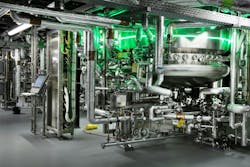The world has changed since COVID-19, and one of the most significant changes has been a paradigm shift in the approach to developing modern treatments for a much wider array of ailments. As pressure increased to find treatments for COVID, the world and the pharmaceutical industry saw exactly how fast the development pipeline can operate if it was set up for success. While there were societal and regulatory factors unique to the pandemic that made pipeline acceleration possible, innovators are working to adapt technologies and strategies to shorten treatment development timelines.
The result has been a new focus on innovation to dramatically accelerate the pharma pipeline and deliver treatments to patients in need faster than ever. Accomplishing this shift has required developers, manufacturers and automation suppliers to come together in new ways — leveraging software and automation, while simultaneously shifting the internal and external culture around pharma manufacturing. Ultimately, much of that change is aimed at streamlining one of the most time-consuming parts of treatment development: technology transfer.
A key element of speeding technology transfer is rethinking the way teams manage data and scalability across the pipeline. Today’s forward-thinking developers and contract manufacturers are re-examining their business models to build a culture of standardization, leveraging digital systems and new workplace processes to reduce the time it takes to move from research to full-scale commercial manufacturing and distribution.
However, the transition does not stop there. Those same innovators are also working closely together to develop solutions that further reduce bottlenecks and lay the foundation for an even more advanced future of one-click technology transfer.
Trust and technology
This evolving model of drug development and manufacturing is an important approach at the global pharma innovator Bristol Myers Squibb (BMS), as illustrated by the company’s efforts to integrate advanced technologies and build a culture of trust to streamline the technology transfer process. With an increased focus on precision medicine and personalized therapies, BMS is leveraging innovative strategies to accelerate research and development, aiming to bring treatments to patients with unprecedented speed and efficiency.
One such approach is the deployment of Industry 4.0 and 5.0 capabilities, including artificial intelligence (AI) and machine learning (ML). These advanced technologies are utilized for deeper digitalization, data mining, predictive modeling and in silico molecular design. By providing more accurate predictions and insights, AI and ML are transforming the landscape of clinical trials. These tools can enhance the efficiency of technology transfer, ensuring a smooth transition from research to clinical trials, and ultimately, to commercial manufacturing.
Trust is a fundamental component of BMS’ strategy, working hand-in-hand with technological advancements. The company has established a continuous testing and improvement environment, designed on a three-tiered infrastructure that includes operations and behaviors at the core, business and site levels. Within each tier, changes are rigorously tested and validated through automated tools, helping to ensure accuracy and reliability before deployment. This meticulous process builds confidence across the BMS network, allowing each site to implement updates with assurance of their precision. Such consistency helps prevent errors and deviations in the technology transfer process, enhancing overall efficiency and reducing time to market.
Another cornerstone of BMS’ strategy is digital health integration, driving transformative changes in clinical practices. By placing patients at the center of this evolution, BMS aims to improve patient outcomes through digital technologies. This comprehensive approach ensures that every aspect of BMS’ operations, from research and development to manufacturing and commercialization, is streamlined and efficient. The integration of digital health technologies facilitates real-time monitoring and adjustments, improving the quality and effectiveness of treatments.
Bristol Myers Squibb’s integration of advanced technologies and cultivation of a culture of trust are
pivotal in streamlining the technology transfer process. By leveraging AI, ML, predictive sciences and digital health technologies, BMS is accelerating the development and delivery of new treatments. The company’s commitment to continuous improvement and rigorous testing ensures that technology transfer is not only efficient but also reliable. This holistic strategy is setting a new standard in the pharma industry, ultimately benefiting patients and driving innovation in life sciences.
Contract manufacturers forge ahead
Changes to accommodate an accelerated time to market are not only happening at traditional development and manufacturing companies, but also at contract development and manufacturing organizations.
To better meet the needs of a changing marketplace, biologics contract manufacturer FUJIFILM Diosynth Biotechnologies has shifted its approach to one more targeted to end-to-end life cycle partnerships built around standardization and modularity. The CDMO’s goal is to digitalize and automate everything around the transfer of recipes, and to align the company’s approach through automation so all equipment and automation processes and procedures are standardized across a wide-reaching network of sites.
The FUJIFILM Diosynth Biotechnologies approach is directly focused on accelerating time to market by reducing the time and complexity of technology transfer programs. The more things are the same at each manufacturing site, the easier it is to copy the automation and setup of a recipe from site to site, even when those sites increase or decrease in scale.
The CDMO is accomplishing this shift by exploring the similarities and differences among customer programs and finding viable and robust ways to align on the variations. This empowers the company to create a more robust standard that also allows for flexibility to accommodate the specific models and processes for a given product.
An example of an opportunity for such standardization can be seen in the antibody manufacturing process. Many companies perform nearly the same process, with only a few variations that have evolved as they invented their own solutions. Many of those variants can be either designed as options in a process or standardized out of the process. The benefit of following FUJIFILM Diosynth Biotechnologies’ recommendations for standardization is the capability to use a system of near-seamless scalability and global reach from the earliest moments of production.
Consider a product manufactured in a uniquely designed 2k bioreactor facility. If demand skyrockets and the manufacturing must be moved to a 10k or 20k facility, the product will be subject to many delays and complexities, and the technology transfer steps will have to be reperformed with each change. In contrast, a product designed around FUJIFILM Diosynth Biotechnologies’ standardized ecosystem can be replicated quickly and easily in any size facility to expand output and reach.
Moreover, such a configuration can be represented in a joint master file and submitted to regulatory authorities so the product can potentially be pre-approved for manufacture from various nodes of the CDMO’s standardized global network — reducing or eliminating the need to re-perform technology transfer with every change.
This new paradigm of operation and partnership empowers pharma companies to unlock increased speed to market through better planning from the earliest stages of development. At the beginning of a new project, partners can provide their portfolio data and share their projections, expectations and needs, working closely with FUJIFILM Diosynth Biotechnologies to see how those projections can be met by scheduling capacity and capability on the existing infrastructure. Instead of
working from a request for proposal with no context, the CDMO can help companies identify next steps and prepare for the needs that materialize beyond the immediate, eliminating bottlenecks and unlocking the flexibility and accessibility necessary to shorten manufacturing timelines, even while navigating change.
Automation at the core
As drug developers and contract manufacturers evolve their pipelines to accelerate speed to market, both rely on a powerful automation layer to accomplish the necessary changes, and to reduce or eliminate deviations. As a result, automation suppliers are evolving their technology alongside pharma organizations to provide a faster pipeline for people in need of new therapies.
First and foremost, automation suppliers are helping pharma manufacturers digitalize. Paper records are not conducive to a streamlined, fast-moving development and manufacturing environment, but neither is a wide diaspora of digital solutions that are not seamlessly integrated. Today’s manufacturers must manage a vast array of factors, including version control, maintaining the link between a recipe and its parameters, identifying where a treatment is in the pipeline, monitoring change and more. Moreover, all those elements must be translated into recipes a manufacturer can use, so it is critical to make the technology transfer process more seamless.
One critical element of this transition is new tools, such as process and knowledge management (PKM) software, to close the gap more effectively in technology transfer. PKM software can electronically capture every recipe decision made across the development pipeline, ensuring it is standardized and accurate, as well as automatically manage calculations for easier scale-up across different stages.
Forward-thinking organizations are also implementing technologies like process analytical technology (PAT) in their automation infrastructure to leverage in-line, continuous, closed-loop process verification and control. Armed with quality information in real time, teams can more easily avoid deviations, and potentially unlock real-time quality release for increased speed to market.
However, currently available software solutions cannot engineer all the complexity out of technology transfer. That is why key stakeholders in the pharma industry — across automation, research and development, manufacturing and more — are coming together to build a one-click technology transfer framework to align on a set of standards for centralized transport and translation of data. Their goal is to integrate the technology transfer process, creating a holistic product platform for management, sharing and translation of data, using open source and open standards to align on the best way to translate recipes into automation systems.
Automation suppliers are also working hard to improve flexible manufacturing capabilities, designing new software solutions that are easily and seamlessly reconfigurable. These solutions require a move away from traditional automation engineering, where processes are designed around static models, set up once, and then run for years or decades with few changes.
Next generation automation systems will instead follow manufacturers’ new needs. Such solutions might be designed with the capability to build varying, modular plant models, and to then adjust them as needed. Or some automation systems may expand parameterization to include equipment in addition to ingredients. Ultimately, these types of solutions will allow users to change processes, recipes and equipment as needed, while simultaneously maintaining an accurate audit trail to historize what has been done, paving the path for faster regulatory approval, even as options for configuration expand exponentially.
Navigating the paradigm shift
The need to bring new treatments to patients quickly and safely is nothing new. Pharma organizations have been improving their processes for decades and have continuously achieved incremental gains. What has changed is that manufacturers have begun to make massive shifts in their capability to develop more standardized, modular processes that will lead to a step-change that was not previously possible.
As both science and technology innovations evolve, pharma organizations have the tools to build a new roadmap for the future. That new roadmap typically moves away from blockbuster drug production over decades and instead favors flexible capabilities to quickly adjust for new discoveries, needs and market factors. However, no single organization can accomplish that goal alone. Instead, developers, manufacturers and automation suppliers will all need to work together to help build a new manufacturing future founded in open standards, seamless integration and data mobility from end to end.
The key players are already coming together to make this new paradigm a reality, and there is room for input from organizations just beginning to shift their strategies to increase their speed to market. For those interested in shaping the future of the treatment pipeline, there has never been a better time to get in the game.







